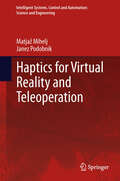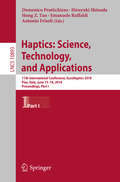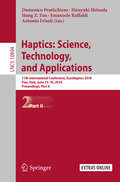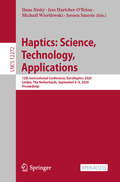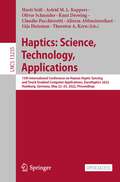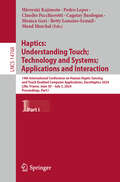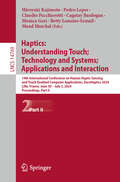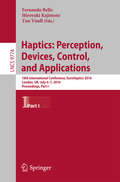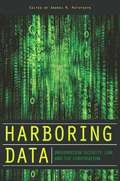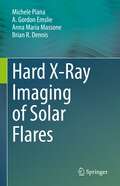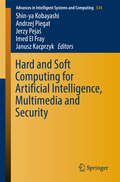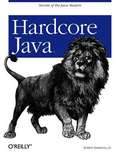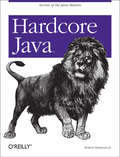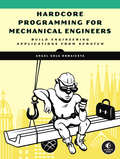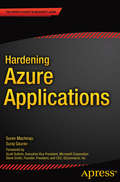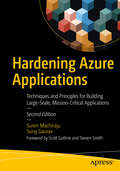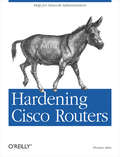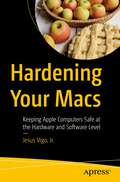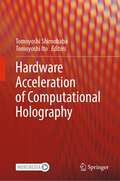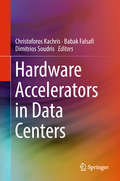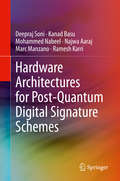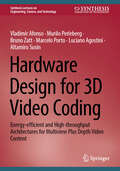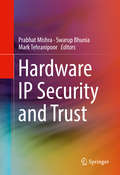- Table View
- List View
Haptics for Virtual Reality and Teleoperation
by Matjaž Mihelj Janez PodobnikThis book covers all topics relevant for the design of haptic interfaces and teleoperation systems. The book provides the basic knowledge required for understanding more complex approaches and more importantly it introduces all issues that must be considered for designing efficient and safe haptic interfaces. Topics covered in this book provide insight into all relevant components of a haptic system. The reader is guided from understanding the virtual reality concept to the final goal of being able to design haptic interfaces for specific tasks such as nanomanipulation. The introduction chapter positions the haptic interfaces within the virtual reality context. In order to design haptic interfaces that will comply with human capabilities at least basic understanding of human sensors-motor system is required. An overview of this topic is provided in the chapter related to human haptics. The book does not try to introduce the state-of-the-art haptic interface solutions because these tend to change quickly. Only a careful selection of different kinematic configurations is shown to introduce the reader into this field. Mathematical models of virtual environment, collision detection and force rendering topics are strongly interrelated and are described in the next two chapters. The interaction with the virtual environment is simulated with a haptic interface. Impedance and admittance based approaches to haptic robot control are presented. Stability issues of haptic interaction are analyzed in details and solutions are proposed for guaranteeing stable and safe operation. Finally, haptic interaction is extended to teleoperation systems. Virtual fixtures which improve the teleoperation and human-robot cooperation in complex environments are covered next and the last chapter presents nanomanipulation as one specific example of teleoperation.
Haptics: 11th International Conference, EuroHaptics 2018, Pisa, Italy, June 13-16, 2018, Proceedings, Part I (Lecture Notes in Computer Science #10893)
by Domenico Prattichizzo Hiroyuki Shinoda Hong Z. Tan Emanuele Ruffaldi Antonio FrisoliThe two-volume set LNCS 10893 and 10894 constitutes the refereed proceedings of the 11th International Conference EuroHaptics 2018, held in Pisa, Italy, in June 2018. The 95 papers (40 oral presentations and554 poster presentations) presented were carefully reviewed and selected from 138 submissions. These proceedings reflect the multidisciplinary nature of EuroHaptics and cover all aspects of haptics, including neuroscience, psychophysics, perception, engineering, computing, interaction, virtual reality and arts.
Haptics: 11th International Conference, EuroHaptics 2018, Pisa, Italy, June 13-16, 2018, Proceedings, Part II (Lecture Notes in Computer Science #10894)
by Domenico Prattichizzo Hiroyuki Shinoda Hong Z. Tan Emanuele Ruffaldi Antonio FrisoliThe two-volume set LNCS 10893 and 10894 constitutes the refereed proceedings of the 11th International Conference EuroHaptics 2018, held in Pisa, Italy, in June 2018. The 95 papers (40 oral presentations and 554 poster presentations) presented were carefully reviewed and selected from 138 submissions. These proceedings reflect the multidisciplinary nature of EuroHaptics and cover all aspects of haptics, including neuroscience, psychophysics, perception, engineering, computing, interaction, virtual reality and arts.
Haptics: 12th International Conference, EuroHaptics 2020, Leiden, The Netherlands, September 6–9, 2020, Proceedings (Lecture Notes in Computer Science #12272)
by Michaël Wiertlewski Ilana Nisky Jess Hartcher-O’Brien Jeroen SmeetsThis open access book constitutes the proceedings of the 12th International Conference on Human Haptic Sensing and Touch Enabled Computer Applications, EuroHaptics 2020, held in Leiden, The Netherlands, in September 2020. The 60 papers presented in this volume were carefully reviewed and selected from 111 submissions. The were organized in topical sections on haptic science, haptic technology, and haptic applications. This year's focus is on accessibility.
Haptics: 13th International Conference on Human Haptic Sensing and Touch Enabled Computer Applications, EuroHaptics 2022, Hamburg, Germany, May 22–25, 2022, Proceedings (Lecture Notes in Computer Science #13235)
by Claudio Pacchierotti Thorsten A. Kern Hasti Seifi Oliver Schneider Astrid M. L. Kappers Knut Drewing Alireza Abbasimoshaei Gijs HuismanThis open access book constitutes the proceedings of the 13th International Conference on Human Haptic Sensing and Touch Enabled Computer Applications, EuroHaptics 2022, held in Hamburg, Germany, in May 2022.The 36 regular papers included in this book were carefully reviewed and selected from 129 submissions. They were organized in topical sections as follows: haptic science; haptic technology; and haptic applications.
Haptics: 14th International Conference on Human Haptic Sensing and Touch Enabled Computer Applications, EuroHaptics 2024, Lille, France, June 30 – July 3, 2024, Proceedings, Part I (Lecture Notes in Computer Science #14768)
by Claudio Pacchierotti Hiroyuki Kajimoto Pedro Lopes Maud Marchal Cagatay Basdogan Monica Gori Betty Lemaire-SemailThe two-volume set LNCS 14768 + 14769 constitutes the refereed proceedings of the 14th International Conference on Human Haptic Sensing and Touch Enabled Computer Applications, EuroHaptics 2024, held in Lille, France, during June 30 – July 3, 2024. The 81 full papers presented were carefully reviewed and selected from 142 submissions. They were organized in topical sections as follows: understanding touch; technology and systems; applications and interaction.
Haptics: 14th International Conference on Human Haptic Sensing and Touch Enabled Computer Applications, EuroHaptics 2024, Lille, France, June 30 – July 3, 2024, Proceedings, Part II (Lecture Notes in Computer Science #14769)
by Claudio Pacchierotti Hiroyuki Kajimoto Pedro Lopes Maud Marchal Cagatay Basdogan Monica Gori Betty Lemaire-SemailThe two-volume set LNCS 14768 + 14769 constitutes the refereed proceedings of the 14th International Conference on Human Haptic Sensing and Touch Enabled Computer Applications, EuroHaptics 2024, held in Lille, France, during June 30 – July 3, 2024. The 81 full papers presented were carefully reviewed and selected from 142 submissions. They were organized in topical sections as follows: understanding touch; technology and systems; applications and interaction.
Haptics: Perception, Devices, Control, and Applications
by Hiroyuki Kajimoto Yon Visell Fernando BelloThe two-volume set LNCS 9774 and 9775 constitutes the refereed proceedings of the 10th International Conference EuroHaptics 2016, held in London, UK, in July 2016. The 100 papers (36 oral presentations and 64 poster presentations) presented were carefully reviewed and selected from 162 submissions. These proceedings reflect the multidisciplinary nature of EuroHaptics and cover topics such as perception of hardness and softness; haptic devices; haptics and motor control; tactile cues; control of haptic interfaces; thermal perception; robotics and sensing; applications.
Harboring Data
by Andrea M. MatwyshynMatwyshyn (legal studies and business ethics, U. of Pennsylvania) compiles 10 articles by law and other scholars, information security professionals, and other experts from the US, UK, Canada, and Hong Kong on the business, legal, and social dynamics affecting corporate information security and data breaches. They discuss the need to adopt a multidisciplinary lens in analyzing information security; public aspects of corporate information security; protecting intellectual property assets; health, financial, and children's data, including HIPAA regulations; and changing contract law norms and new business models in social networking websites. Annotation c2010 Book News, Inc. , Portland, OR (booknews. com)
Hard Real-Time Computing Systems: Predictable Scheduling Algorithms and Applications
by Giorgio ButtazzoThis book is a basic treatise on real-time computing, with particular emphasis on predictable scheduling algorithms. The main objectives of the book are to introduce the basic concepts of real-time computing, illustrate the most significant results in the field, and provide the basic methodologies for designing predictable computing systems useful in supporting critical control applications.Hard Real-Time Computing Systems is written for instructional use and is organized to enable readers without a strong knowledge of the subject matter to quickly grasp the material. Technical concepts are clearly defined at the beginning of each chapter, and algorithm descriptions are corroborated through concrete examples, illustrations, and tables. This new, fourth edition includes new sections to explain the variable-rate task model, how to improve predictability and safety in cyber-physical real-time systems that exploit machine learning algorithms, additional coverage on Response Time Analysis, and a new chapter on implementing periodic real-time tasks under Linux..
Hard X-Ray Imaging of Solar Flares
by Michele Piana A. Gordon Emslie Anna Maria Massone Brian R. DennisThe idea for this text emerged over several years as the authors participated in research projects related to analysis of data from NASA's RHESSI Small Explorer mission. The data produced over the operational lifetime of this mission inspired many investigations related to a specific science question: the when, where, and how of electron acceleration during solar flares in the stressed magnetic environment of the active Sun.A vital key to unlocking this science problem is the ability to produce high-quality images of hard X-rays produced by bremsstrahlung radiation from electrons accelerated during a solar flare. The only practical way to do this within the technological and budgetary limitations of the RHESSI era was to opt for indirect modalities in which imaging information is encoded as a set of two-dimensional spatial Fourier components. Radio astronomers had employed Fourier imaging for many years. However, differently than for radio astronomy, X-ray images produced by RHESSI had to be constructed from a very limited number of sparsely distributed and very noisy Fourier components. Further, Fourier imaging is hardly intuitive, and extensive validation of the methods was necessary to ensure that they produced images with sufficient accuracy and fidelity for scientific applications.This book summarizes the results of this development of imaging techniques specifically designed for this form of data. It covers a set of published works that span over two decades, during which various imaging methods were introduced, validated, and applied to observations. Also considering that a new Fourier-based telescope, STIX, is now entering its nominal phase on-board the ESA Solar Orbiter, it became more and more apparent to the authors that it would be a good idea to put together a compendium of these imaging methods and their applications. Hence the book you are now reading.
Hard and Soft Computing for Artificial Intelligence, Multimedia and Security
by Janusz Kacprzyk Imed El Fray Jerzy Pejaś Shin-Ya Kobayashi Andrzej PiegatThis book gathers the proceedings of the 20th International Conference on Advanced Computer Systems 2016, held in Międzyzdroje (Poland) on October 19-21, 2016. Addressing topics that include artificial intelligence (AI), software technologies, multimedia systems, IT security and design of information systems, the main purpose of the conference and the book is to create an opportunity to exchange significant insights on this area between science and business. In particular, this expertise concerns the use of hard and soft computational methods for artificial intelligence, image and data processing, and finally, the design of information and security systems. The book contains a collection of carefully selected, peer-reviewed papers, combining high-quality original unpublished research, case studies, and implementation experiences.
Hardcore Java
by Robert Simmons JrJava has quickly become one of the most important languages in programming, particularly for professional and enterprise-level projects. From its infancy as a language primarily used for web applets to its maturity through servlets, Enterprise JavaBeans, and database access, Java has become a complex and robust tool for today's developer. Hardcore Java takes this language and breaks it apart, piece by piece, revealing the important secrets and tricks that will take you from a junior-level programmer to a seasoned and expert developer. You'll fly through the fundamentals and quickly find yourself learning about advanced memory management techniques, optimization and bytecode-level enhancements, and the techniques required to build lightning-fast GUIs. Throughout the book, you'll also master the art of writing and maintaining bulletproof and error-proof code, all while grasping the intricacies of the Java language. Hardcore Java covers: Use of the final keyword to optimize and protect your Java classes. Complete and thorough coverage of all types of nested classes, including how to optimize anonymous and inner classes. Detailed discussion of immutable objects, including unique tips on when to use them (and when not to). Elimination of bugs through exception-handling management. In-depth studies of constants, including their impact on the Java memory model. The most thorough discussion of reflection in print, moving far beyond other books' "Hello World" coverage. Construction and use of dynamic proxies, in both Java Standard and Enterprise editions. Expansive coverage of weak references, including usage patterns and their role in garbage collection and memory management. Hardcore Java is an invaluable addition to every programmer's library, and even the most advanced developers will find themselves moving beyond their own conceptions into truly advanced applications of the language. Thousands of lines of code, heavily commented and easily runnable, illustrate each concept in the book.
Hardcore Java: Secrets of the Java Masters
by Robert Simmons JrJava has quickly become one of the most important languages in programming, particularly for professional and enterprise-level projects. From its infancy as a language primarily used for web applets to its maturity through servlets, Enterprise JavaBeans, and database access, Java has become a complex and robust tool for today's developer.Hardcore Java takes this language and breaks it apart, piece by piece, revealing the important secrets and tricks that will take you from a junior-level programmer to a seasoned and expert developer. You'll fly through the fundamentals and quickly find yourself learning about advanced memory management techniques, optimization and bytecode-level enhancements, and the techniques required to build lightning-fast GUIs. Throughout the book, you'll also master the art of writing and maintaining bulletproof and error-proof code, all while grasping the intricacies of the Java language.Hardcore Java covers:Use of the final keyword to optimize and protect your Java classes.Complete and thorough coverage of all types of nested classes, including how to optimize anonymous and inner classes.Detailed discussion of immutable objects, including unique tips on when to use them (and when not to).Elimination of bugs through exception-handling management.In-depth studies of constants, including their impact on the Java memory model.The most thorough discussion of reflection in print, moving far beyond other books' "Hello World" coverage.Construction and use of dynamic proxies, in both Java Standard and Enterprise editions.Expansive coverage of weak references, including usage patterns and their role in garbage collection and memory management.Hardcore Java is an invaluable addition to every programmer's library, and even the most advanced developers will find themselves moving beyond their own conceptions into truly advanced applications of the language. Thousands of lines of code, heavily commented and easily runnable, illustrate each concept in the book.
Hardcore Programming for Mechanical Engineers: Build Engineering Applications from Scratch
by Angel Sola OrbaicetaHardcore Programming for Mechanical Engineers is for intermediate programmers who want to write good applications that solve tough engineering problems – from scratch.This book will teach you how to solve engineering problems with Python. The &“hardcore&” approach means that you will learn to get the correct results by coding everything from scratch. Forget relying on third-party software – there are no shortcuts on the path to proficiency. Instead, using familiar concepts from linear algebra, geometry and physics, you&’ll write your own libraries, draw your own primitives, and build your own applications. Author Angel Sola covers core programming techniques mechanical engineers need to know, with a focus on high-quality code and automated unit testing for error-free implementations. After basic primers on Python and using the command line, you&’ll quickly develop a geometry toolbox, filling it with lines and shapes for diagramming problems. As your understanding grows chapter-by-chapter, you&’ll create vector graphics and animations for dynamic simulations; you&’ll code algorithms that can do complex numerical computations; and you&’ll put all of this knowledge together to build a complete structural analysis application that solves a 2D truss problem – similar to the software projects conducted by real-world mechanical engineers. You'll learn: • How to use geometric primitives, like points and polygons, and implement matrices • Best practices for clean code, including unit testing, encapsulation, and expressive names • Processes for drawing images to the screen and creating animations inside Tkinter&’s Canvas widget • How to write programs that read from a file, parse the data, and produce vector images • Numerical methods for solving large systems of linear equations, like the Cholesky decomposition algorithm
Hardening Azure Applications
by Suren Machiraju Suraj GauravLearn what it takes to build large scale, mission critical applications -hardened applications- on the Azure cloud platform. This 208 page book covers the techniques and engineering principles that every architect and developer needs to know to harden their Azure/. NET applications to ensure maximum reliability and high availability when deployed at scale. While the techniques are implemented in . NET and optimized for Azure, the principles here will also be valuable for users of other cloud-based development platforms. Applications come in a variety of forms, from simple apps that can be built and deployed in hours to mega-scale apps that need significantly higher engineering rigor and robust organizations to deliver them. How do you build such massively scalable applications to keep pace with traffic demands while always being 'online' with five 9's availability? The authors take you step by step through the process of evaluating and building applications with the appropriate hardness attributes. For example, it is easy to say that an application should be available "all the time", but it is very important to understand what each level of 9 for availability means and the resulting implications on engineering and resources. The book explains the details required for developers and IT Pros to get it right in Azure. What you'll learn Why it is important to harden Azure/. NET applications and ensure they are always available. Characteristics of advanced applications Design for failure - how to avoid common mistakes and prevent failure Design for scale - prepared to scale up and scale down the application to fully leverage the best of Cloud infrastructure Techniques to secure the applications without restricting the business goals of the company How to train teams and people to run such hardened services Who this book is for Developers creating high reliability Azure applications in . NET plus most other popular environments like Java, PHP, node. JS, Python, Apache, etc. Architects and CIOs. Table of Contents 1. Overview of Azure 2. Cloud applications and their spectrum 3. Hardened cloud applications 4. Service fundamentals - Instrumentation, Telemetry and Monitoring 5. Key Application experiences - Latency, Scalability and Throughput 6. Failures and their inevitability 7. Failure detection and recovery oriented computing 8. High Availability, Scalability and Disaster Recovery 9. Availability and economics of 9s 10. Security 11. Modernization of software organizations
Hardening Azure Applications: Techniques and Principles for Building Large-Scale, Mission-Critical Applications
by Suren Machiraju Suraj GauravBuild large-scale, mission-critical hardened applications on the Azure cloud platform. This 2nd edition provides information on the newer features in Azure, such as Linux extensions and supporting Azure Services such as HDInsight and SQL Server on Linux. Updated with new applications Hardening Azure Applications also discusses Scale Sets (VMSS), a major upgrade that enables autoscaling and seamlessly makes machines ready for high availability. The authors take you step by step through the process of evaluating and building applications with the appropriate hardness attributes. After a small introduction to cloud computing, you will learn about various cloud and hardened cloud applications in detail. Next, you will discover service fundamentals such as instrumentation, telemetry, and monitoring followed by key application experiences. Further, you will cover availability and the economics of 9s. Towards the end, you will see how to secure your application and learn about the modernization of software organisations, a new topic in this edition.After reading this book, you will master the techniques and engineering principles that every architect and developer needs to know to harden their Azure/.NET applications to ensure maximum reliability and high availability when deployed at scale.What You Will LearnUse techniques and principles to harden Azure/.NET applicationsSecure your applications on AzureCreate a scale set on Azure Work with service fundamentals such as instrumentation, telemetry, and monitoringWho This Book Is ForDevelopers and IT professionals who are working on Azure applications.
Hardening Cisco Routers: Help for Network Administrators
by Thomas AkinAs a network administrator, auditor or architect, you know the importance of securing your network and finding security solutions you can implement quickly. This succinct book departs from other security literature by focusing exclusively on ways to secure Cisco routers, rather than the entire network. The rational is simple: If the router protecting a network is exposed to hackers, then so is the network behind it. Hardening Cisco Routers is a reference for protecting the protectors. Included are the following topics:The importance of router security and where routers fit into an overall security planDifferent router configurations for various versions of Cisco?s IOSStandard ways to access a Cisco router and the security implications of eachPassword and privilege levels in Cisco routersAuthentication, Authorization, and Accounting (AAA) controlRouter warning banner use (as recommended by the FBI) Unnecessary protocols and services commonly run on Cisco routersSNMP securityAnti-spoofingProtocol security for RIP, OSPF, EIGRP, NTP, and BGPLogging violationsIncident responsePhysical securityWritten by Thomas Akin, an experienced Certified Information Systems Security Professional (CISSP) and Certified Cisco Academic Instructor (CCAI), the book is well organized, emphasizing practicality and a hands-on approach. At the end of each chapter, Akin includes a Checklist that summarizes the hardening techniques discussed in the chapter. The Checklists help you double-check the configurations you have been instructed to make, and serve as quick references for future security procedures.Concise and to the point, Hardening Cisco Routers supplies you with all the tools necessary to turn a potential vulnerability into a strength. In an area that is otherwise poorly documented, this is the one book that will help you make your Cisco routers rock solid.
Hardening Your Macs: Keeping Apple Computers Safe at the Hardware and Software Level
by Jesus Vigo, Jr.Learn the skills and solutions required to secure your Mac's operating system, the underlying hardware, and allow users to get work done safely. This book will show you how to create a Mac that’s made of steel and won’t buckle when attacked!Ok, there’s no such thing as unhackable. No magic tool or silver bullet will eliminate risk in all forms. Security is an ongoing journey – not a simple action or software application. And that is exactly what you’ll learn to master—the foundational knowledge, skills, and mindset to holistically protect Macs. Regardless of whether it’s your personal iMac or a fleet of MacBook Pro’s assigned to the remote employees within your organization, you’ll be able to limit access while identifying and mitigating risk unique to your environment.In addition to the information security best practices pertaining to protecting Apple computers, you’ll pivot to a coherent, security-focused mindset to better understand macOS-specific security. You’ll learn how it works and what tools and software are available to help. Both native and 3rd-party tool are covered. Safe guard your system’s privacy data and capitalize on effectively locking down the security of your Mac computers against known threats and newer trends that continue to evolve.Hardening Your Macs is the perfect roadmap to stopping malicious attacks and bad actors from spying on users through cameras, microphones, and other built-in tools that could potentially be used against users and organizations alike. What You'll LearnGrasp the mindset of attackers—how they plan and execute malicious incursionsImplement hardware solutions as well as software safeguardsTake advantage of Apple's built-in macOS security features in addition to 3rd party toolsAvoid attacks on your system that could compromise sensitive corporate data and personally identifiable information Who This Book Is ForIT admins responsible for managing Mac device security. Additionally users of Apple products that may have some experience using the platform in general but are not versed in security, as well as, those switching from Windows platforms will find useful information here. And anyone that wishes to expand their information security skills and/or develop a security-focused mindset to better protect their personal information and privacy data from the numerous and growing threats in the wild, such as malware and phishing.
Hardware Acceleration of Computational Holography
by Tomoyoshi Shimobaba Tomoyoshi ItoThis book explains the hardware implementation of computational holography and hardware acceleration techniques, along with a number ofconcrete example source codes that enable fast computation. Computational holography includes computer-based holographictechnologies such as computer-generated hologram and digital holography, for which acceleration of wave-optics computation is highly desirable.This book describes hardware implementations on CPUs (Central Processing Units), GPUs (Graphics Processing Units) and FPGAs (Field ProgrammableGate Arrays).This book is intended for readers involved in holography as well as anyone interested in hardware acceleration.
Hardware Accelerators in Data Centers
by Dimitrios Soudris Christoforos Kachris Babak FalsafiThis book provides readers with an overview of the architectures, programming frameworks, and hardware accelerators for typical cloud computing applications in data centers. The authors present the most recent and promising solutions, using hardware accelerators to provide high throughput, reduced latency and higher energy efficiency compared to current servers based on commodity processors. Readers will benefit from state-of-the-art information regarding application requirements in contemporary data centers, computational complexity of typical tasks in cloud computing, and a programming framework for the efficient utilization of the hardware accelerators.
Hardware Architectures for Post-Quantum Digital Signature Schemes
by Ramesh Karri Deepraj Soni Kanad Basu Mohammed Nabeel Najwa Aaraj Marc ManzanoThis book explores C-based design, implementation, and analysis of post-quantum cryptography (PQC) algorithms for signature generation and verification. The authors investigate NIST round 2 PQC algorithms for signature generation and signature verification from a hardware implementation perspective, especially focusing on C-based design, power-performance-area-security (PPAS) trade-offs and design flows targeting FPGAs and ASICs.Describes a comprehensive set of synthesizable c code base as well as the hardware implementations for the different types of PQC algorithms including lattice-based, code-based, and multivariate-based;Demonstrates the hardware (FPGA and ASIC) and hardware-software optimizations and trade-offs of the NIST round 2 signature-based PQC algorithms;Enables designers to build hardware implementations that are resilient to a variety of side-channels.
Hardware Design for 3D Video Coding: Energy-efficient and High-throughput Architectures for Multiview Plus Depth Video Content (Synthesis Lectures on Engineering, Science, and Technology)
by Bruno Zatt Luciano Agostini Vladimir Afonso Murilo Perleberg Marcelo Porto Altamiro SusinThis book focuses on the research and development challenges posed by 3D video systems based on multi-view plus depth (MVD) technology. This technology can produce a realistic immersive experience generating synthetic video views on the decoder side, reducing the amount of information on the encoder side. The discussion presented in this book explores the MVD characteristics to propose high-throughput and energy-efficient architectures/systems, focusing on 3D-HEVC, the state-of-the-art standard for exploiting the MVD concept. The book includes an extensive discussion of the 3D-HEVC video encoding, followed by an in-depth evaluation of the 3D-HEVC reference software behavior. Then, the book presents in detail a set of high-throughput and energy-efficient architectures targeting the three main prediction steps inside the 3D-HEVC: intra-frame prediction, inter-frame prediction, and inter-view prediction.
Hardware IP Security and Trust
by Swarup Bhunia Prabhat Mishra Mark TehranipoorThis book provides an overview of current Intellectual Property (IP) based System-on-Chip (SoC) design methodology and highlights how security of IP can be compromised at various stages in the overall SoC design-fabrication-deployment cycle. Readers will gain a comprehensive understanding of the security vulnerabilities of different types of IPs. This book would enable readers to overcome these vulnerabilities through an efficient combination of proactive countermeasures and design-for-security solutions, as well as a wide variety of IP security and trust assessment and validation techniques. This book serves as a single-source of reference for system designers and practitioners for designing secure, reliable and trustworthy SoCs.
Hardware Oriented Authenticated Encryption Based on Tweakable Block Ciphers (Computer Architecture and Design Methodologies)
by Mustafa KhairallahThis book presents the use of tweakable block ciphers for lightweight authenticated encryption, especially applications targeted toward hardware acceleration where such efficient schemes have demonstrated competitive performance and strong provable security with large margins. The first part of the book describes and analyzes the hardware implementation aspects of state-of-the-art tweakable block cipher-based mode ΘCB3. With this approach, a framework for studying a class of tweakable block cipher-based schemes is developed and two family of authenticated encryption algorithms are designed for the lightweight standardization project initiated by the National Institute of Standards and Technology (NIST): Romulus and Remus. The Romulus family is a finalist for standardization and targets a wide range of applications and performance trade-offs which will prove interesting to engineers, hardware designers, and students who work in symmetric key cryptography.
